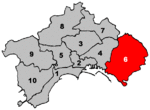National Railway Museum of Pietrarsa

The National Railway Museum of Pietrarsa (Italian: Museo Nazionale Ferroviario di Pietrarsa) lies beside the Naples–Portici railway, between the city of Naples and the towns of Portici and San Giorgio a Cremano. Pietrarsa is an area among these villages in the past known as “Pietra Bianca” (white stone) but it was renamed Pietrarsa (burnt stone) after the eruption of the Vesuvius in 1631. The museum is housed in what was originally the old Bourbon workshop Officine di Pietrarsa, founded in 1840 at the command of Ferdinand II of Bourbon where steam machines for ships and boilers for locomotives were built. The workshop was organized in pavilions (where the collection is today displayed) which housed the various departments, each specializing in a different part of the production cycle.
Excerpt from the Wikipedia article National Railway Museum of Pietrarsa (License: CC BY-SA 3.0, Authors, Images).National Railway Museum of Pietrarsa
Via Pietrarsa, Naples Municipalità 6
Geographical coordinates (GPS) Address External links Nearby Places Show on map
Geographical coordinates (GPS)
| Latitude | Longitude |
|---|---|
| N 40.8217 ° | E 14.3205 ° |
Address
Museo Nazionale Ferroviario di Pietrarsa
Via Pietrarsa
80046 Naples, Municipalità 6
Campania, Italy
Open on Google Maps










